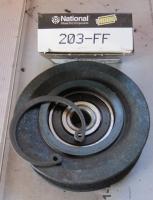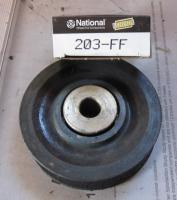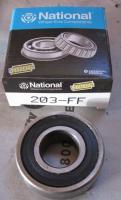Everything posted by Zed Head
-
Great day for a drive/pick and pull score
I agree!. I guess my sense of humor didn't come across. It's not the first time.
-
Great day for a drive/pick and pull score
"My girlfriend convinced me to head up to the pick and pull" - what an odd statement...
-
Best Burger Grilling?
How much for a t-shirt? Maybe I'll buy one - sort of...
-
Best Burger Grilling?
Looks like venus is drumming up awareness of his/her Z Island t-shirts, hats and coins, and the plan has gone awry. She/he has now indirectly insulted Ferrari people also. It's a slippery slope, trying to defend a poor decision.
-
'76 280Z Question on dist/manifold vacuum, dist timing, fuel pressure, brake booster
While I remember, and in case you come across one - I have found that my spare 1978 AFM is mechanically identical to my 1976. It even has the working fuel pump contact switch, even though, according the FSM, the pins connecting to it are "useless." Having worked in manufacturing, it may be that the company gave the same part a new number, during a transition. Later products might not have the switch. Something to consider if you came across a 1978 AFM for cheap. Check for the fuel pump contacts and it might work on your car. My spare 1978 AFM has the Datsun factory label on it, so does not appear to be a reman. But, and I hate to muddy up a muddy situation, there is also the outside possibility that the 1978 has a different spring tension than the 1976. I would be surprised if this was the case but since there is little information on the factory spring tensions, it is a possibility. If we get a few rainy days here I might connect my shop vac to both AFMs and see if the voltages are the same, at the same air flow volume. 1976 is A31-060-001 1978 is A31-604-000 We will be building new parts from scratch by the time we're done here....
-
1977 280Z Voltage gauge "Always On?"
In theory a voltage gauge has infinite resistance. In practice, it's almost infiinite. One of the few things I remember from my classes on electronics. The current draw is tiny. So, yes, the gauge is always on and won't drain the battery. I was recently comparing ECU numbers and found that the 76, 77 and 78 Manual transmission cars all used the same ECU, #A11-600-000. But 77 and 78 Autos used A11-601-000. So there might be a wire or two to the ECU that your ECU won't handle correctly. Just something to be aware of if you run in to a problem, I do not know what the ECU differences might be. I got the information off of various other sites. The fusible links have a high temperature flexible insulation so that they don't melt externally when they go. A lot of people replace them and the mounting base with Maxi-fuses.
-
Best Burger Grilling?
Is this how the "trolling" thing works? Go find a site, join up and try to start an argument/discussion? Seems pretty odd, but that's the internet. "Marketing position with ZCCA" is bait, I assume? Fascinating, but disturbing. At least you put some effort in to the avatar, although it's probably stolen from another site. How many different sites do you typically hit in a week? Amusing aside - avatar view-blocking only works when you are logged in. The avatars are visible to the general public. Some sites show avatars only to logged-in members.
-
help with moustache bar stoppers
I think that the right drawing in Nissanman's picture is of the bushing inside the ends of the moustache bar (the part you burn out when you install urethane). It's from the FSM and shows the top and bottom big washers, and what looks like a small ring of rubber at the top. Datsun could have produced a better picture, I don't think it represents what they put on the cars. The left drawing is the front mount. It's not the greatest either. On my 76 280Z and a 78 280Z that I had, both top and bottom looked like the one on the upper right. It probably matters little which is used, unless mrk3cobra is doing a restoration.
-
help with moustache bar stoppers
The right one on the top picture looks like a 280Z part. I've never seen one like the lower right, with no bumps, until now.
-
Synchromesh worn out?
If you put the transmission in gear before you remove the shifter (or while it's out before you install) you can grab the output shaft and turn it to get the splines lined up, while you're pushing the main shaft lightly against the clutch disc. It also helps to lift up on the clutch disc a little bit with the alignment tool, or just push up on it a little, in to get it perfectly centered, when you're tightening the pressure plate bolts. Otherwise it will drop just a little bit from gravity, making it just a little harder to get the main shaft end in to the pilot bushing hole. The weight of the disc just hangs on the little plastic nub of the alignment tool in the pilot bushing so if you have a weak one, or a loose fit, you can get some misalignment.
-
A/C Idler Pulley Rebuild
Yes it does, but it didn't have any SPAM associated so what the heck. Benefit of the doubt. I'm not really up on how those troll-bit things work. Didn't check that he left immediately and hasn't been back (how do you tell?). What do you think?
-
A/C Idler Pulley Rebuild
Thanks, I'm just trying to add to the knowledge base. I got your first post? Woohoooo...
-
no idle screw?
No wonder it's hard to find. Nice picture. I was just thinking about rigging up something similar for those odd occasions when the AAR is closed, but the engine still needs a little extra bypass air to keep the idle up, certain cold days when you hit lots of stop signs or lights. It would work like a choke, with a knob in the cabin to turn to allow more throttle body bypass. It might also be a cheap or temporary fix for those who don't want to fork out $100 for a new AAR.
-
78 Z at the u-pull it!
Thanks. I assume it's the one on this web page - http://www.cavemanautoparts.com/parts.aspx They don't list the car yet. Must be new inventory.
-
'76 280Z Question on dist/manifold vacuum, dist timing, fuel pressure, brake booster
The critical fact is does it open and close consistently. It might have been stuck open, and you have adjusted your warm idle speed to compensate, giving a low cold idle speed. It is pretty easy to connect 12 volts to the two pins and see if it closes. Then disconnect the power and see if it reopens. Do that a few times and you'll be fairly sure it's working as well as it can.
-
78 Z at the u-pull it!
No link? Is u-pull it a chain like Pick-n-Pull?
-
Aftermarket fuel rails
Uuuummmm....shiny.... http://www.summitracing.com/parts/AEI-13109/ This one has an extra port for a gauge..http://www.summitracing.com/parts/AEI-13101/ Many more options... http://www.summitracing.com/search/Department/Air-Fuel-Delivery/Section/Fuel-Pumps-Regulators/Part-Type/Fuel-Pressure-Regulators/?keyword=regulators
-
no idle screw?
You probably found the throttle blade stop screw. That will change your idle speed, but that's not what it was designed for, and will probably cause other problems. You should really read the FSM. You'll be much happier in the long run.
-
Can someone help identify?...
It looks like your Auxiliary Air Regulator is missing. It would normally be mounted where the two screws are on top of the plate with the water lines running to it. It has battery power connected through that loose plug. Does the car take a while to warm up once it starts? Runs at low idle speed, gradually increasing as it gets warm? The diamond-shaped blocking plate is covering the port for the Air Regulator hose. There should be another hose, maybe connected to the hose to the valve cover, that might be blocked off, although some years used a T-fitting. Your CSV is in the picture on the left, with the fuel line connected to it and an electrical connection. The Air Regulator costs about $100 so maybe the PO decided to do without. It is convenient though to allow you to drive the car while the engine is cold, it keeps the idle up until the engine is warm. Edit - 78zcar beat me while I went to the garage...
-
Weak spark
I should have said "Flame-Thrower" coil, not Blaster. Pertronix recommends this coil with their Ignitor electronic ignition. It's shiny and silver... http://www.pertronix.com/prod/ig/flame/coils/40000_volt.aspx It's on the fenderwell on the distributor side. The aftermarket coils usually have brand markings, the stock ones are flat black and look factory. FW, I think that patjamejam was pointing out his(?, I assume) general unfamiliarity with the car and its parts.
-
Weak spark
I believe that the Pertronix electronic ignition unit can be wired with or without the ballast resistor, depending on the coil that is used. Do you have a shiny silver "Blaster" coil or a dull black stock one? Search Pertronix and you'll find a lot of discussion about the pros and cons of the Pertronix unit. I think that the issue with your ammeter is probably from a different wiring issue, but it might or might not be indicating a problem. The ammeter doesn't tell you a whole lot about what your charging system is doing. Someone who knows ammeters can probably tell you more. In the meantime, if you have a voltmeter, it wouldn't hurt to measure voltage at the battery at low and high rpm to see if your charging system is regulating correctly. Do you know if you have the "stock" alternator or has it been upgraded to internal regulation?
-
Aftermarket fuel rails
Shaking your wiring harness to get your fuel pump running today, building a twin-turbo 3.2 liter stroker motor tomorrow. Looks like quite a journey.
-
A/C Idler Pulley Rebuild
I just replaced the idler pulley bearing on my 1976 280Z. I got the bearing from Baxter Auto Parts ($9.29). Apparently it is a very commonly used bearing, the guy at the counter said he sells about 5 per week. The parts guys know it as the "203" bearing. My pulley used the circlip to retain the bearing. The usual mix of fixtures on the vise, large hammer and large sockets worked to remove the bearing from the pulley and the bushing from the bearing, and for reinstallation. I attached some pictures for anyone who has a similar setup, in case they break a cold sweat like I did, thinking that they might have the bushing on the wrong side after the bearing was already pressed halfway in (I didn't). The pictures are labeled, the bearing shown is the old NTN 6203LB original with the new bearing's box. They are identical. The bushing head goes on the opposite side that the circlip does,and the pulley mounts with the bushing toward the engine. There is a spacer washer that goes between the bearing and dustcover on the front of the pulley to keep the nut from crushing the cover (I already had it installed before I thought to take pictures). As someone has noted in another post (can't find it), the pulley can be removed from its mounting shaft without removing anything else, if you can squeeze your arm and hand down between the fan blades. Thanks to sblake01 for the link to this thread, from my other post - http://www.classiczcars.com/forums/showthread.php?t=40117&highlight=ac+idler
-
no idle screw?
I would bet that there is something in the FSM about adjusting idle speed. Probably in the Maintenance section.
-
Aftermarket fuel rails
The flow rate of your injectors and the engine management system used to control injector open time will be much more important than the fuel rail that you use. Those two will work together with your fuel pressure to supply the necessary amount of fuel to the engine.






